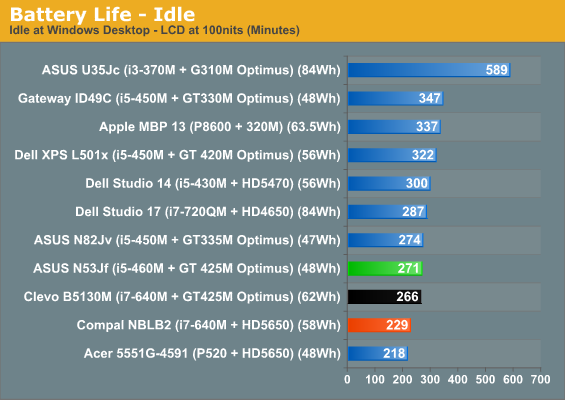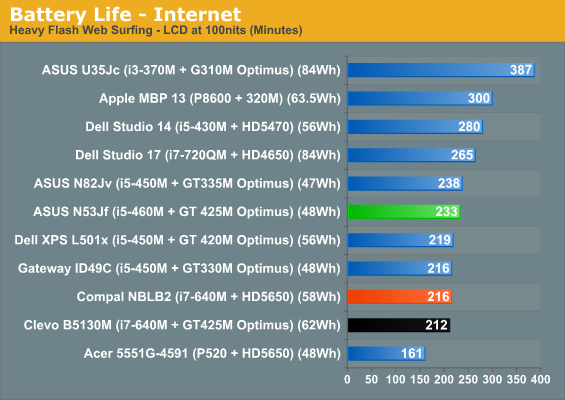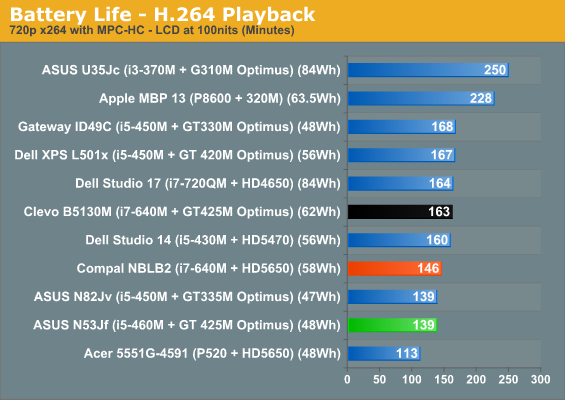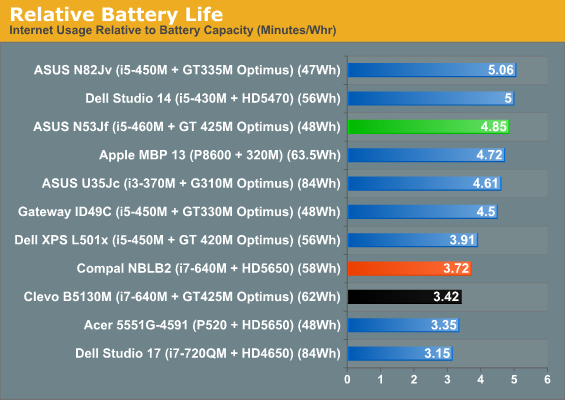ASUS N53JF: Midrange 15.6” 1080p, Take Four
by Jarred Walton on December 28, 2010 1:40 AM ESTASUS N53JF Battery Life: Not Bad for 48Wh, but Please Give Us 63Wh!
We’ve complained about the use of older and smaller 48Wh batteries in midrange notebooks quite a few times, but the N53JF continues that trend. That puts it at a definite disadvantage relative to Dell XPS’ 56Wh battery, as well as Compal’s 58Wh and Clevo’s 62Wh offerings. But higher capacity isn’t the only game in town; making better use of that capacity is still possible with BIOS and hardware optimizations, and ASUS does very well in this regard. Combined with NVIDIA’s Optimus Technology, we end up with roughly four hours of useful battery life, or just under 2.5 hours of H.264 playback.
ASUS also has their “Super Hybrid Engine” available, which underclocks the CPU and locks the maximum multiplier when enabled. We test with modified Power Saver settings normally, which already locks the CPU multiplier to the minimum, but SHE is still able to wring an extra few minutes out of the battery. We left it enabled for the battery life testing, so the results are the best-case scenario. We also disable any unnecessary utilities and software, and set the LCD to 100nits (45% in this case).




Despite having a smaller battery, ASUS beats the Clevo notebook in two of the three tests. The Compal result on the other hand isn’t so surprising, given the always-on GPU. We commented in the past that the Dell XPS had a substandard Internet result (despite multiple test runs), and that shows up again as the one inexplicable loss to the ASUS. In general, though, battery life is decent and enough for typical users. You’ll still want the power brick handy if you play any games or want to watch a Blu-ray from an actual disc, however—we measured just 90 minutes playing an 35Mbps AVC Blu-ray video (Jumper).










65 Comments
View All Comments
visibilityunlimited3 - Wednesday, December 29, 2010 - link
I had problems with my eyes looking at an 14" XGA. I almost went blind before I got my 15.4" Inspiron 1920x1200 screen many years later. My eyes have fewer problems after looking at that high resolution display for many years now.Consider the difference between old dot matrix printers and laser printers. Is reading 1200dpi text uncomfortable? The real problem is Windows being optimized for low res screens. There are a few configuration changes that can help. I actually dual boot with Windows XP and Debian and prefer the Debian for being better equipped to manage the high resolution display. I spent a little extra time fine tuning the X Window System to do exactly what I wanted and I am very comfortable now. I am in no hurry to downgrade to the 1080p display until my old Pentium M gets really tired. The display is that much more important than anything else in my opinion. Thanks Jarred for recognizing the value of the premium displays.
I would like an ebook reader with 1200dpi resolution to match my laser printer and expect that would be very comfortable to use also.
Davelo - Tuesday, December 28, 2010 - link
How many laptops have went bad because of bad BGA solder of Nvidia chips? I've seen so many I would not touch one.DanNeely - Tuesday, December 28, 2010 - link
Weren't those all the first generation lead-free BGA chips? I didn't think any of the newer ones were having problems.JarredWalton - Tuesday, December 28, 2010 - link
Yeah, this is old news. A few anti-NVIDIA sites made a huge deal about the failures, but I never personally had any of those chips fail on me. Of course, I wasn't playing a lot of games on laptops, so maybe that's why. Anyway, anything in the post-8000M era should definitely be fine. Actually, I think it was mostly the old GeForce Go series that had problems.sucram03 - Tuesday, December 28, 2010 - link
Somewhat on & off-topic question: So in all honesty, with such a horrendous screen, where does that leave value-minded users that want a laptop with a nice 1080p screen and a GeForce video card? The application I'm thinking of is CUDA-accelerating H.264/AVC 1080p videos.The XPS 15 isn't listing the B+RG LED as an option, as mentioned in the article. Has anyone else heard from Dell about reasons why/if it will come back? The Clevo seems like an OK option but... well.. it now seems like the only option.
Any thoughts?
JarredWalton - Tuesday, December 28, 2010 - link
At this point, I'd say just wait for the CES announcements and see if anything new turns up. :-)Kaboose - Tuesday, December 28, 2010 - link
Could Dell be holding back the 1080p panels for a sandy laptop in the next few weeks?sucram03 - Tuesday, December 28, 2010 - link
All signs point to yes, especially that suspect smiley face from Jared :) Damn you insider knowledge!Kaboose - Tuesday, December 28, 2010 - link
thank goodness i have been saving up for the past two months in anticipation of sandy bridge and my need for a new portable computer. luckily they coincide.JarredWalton - Tuesday, December 28, 2010 - link
I've got Sandy Bridge, but I have no idea if Dell is holding back panels. I sure hope so...